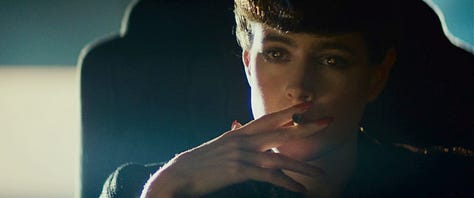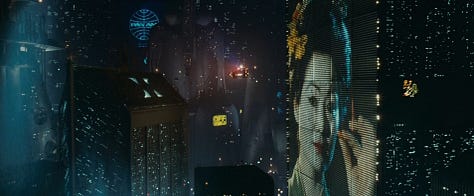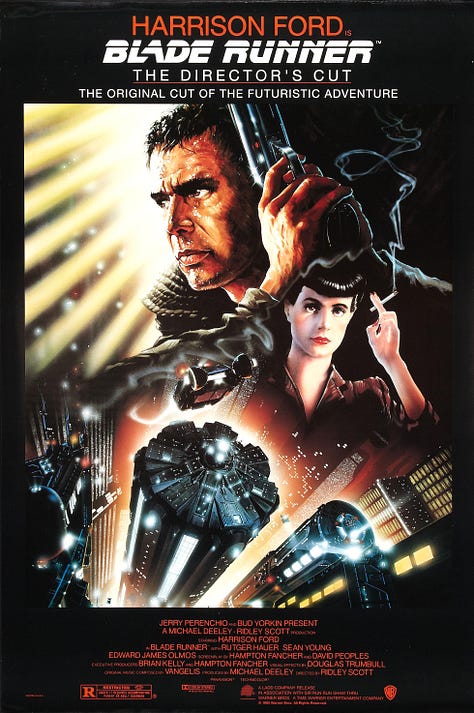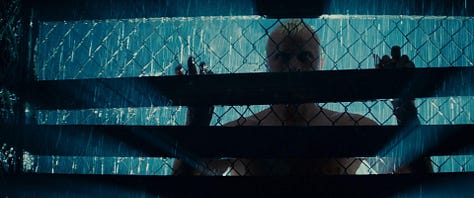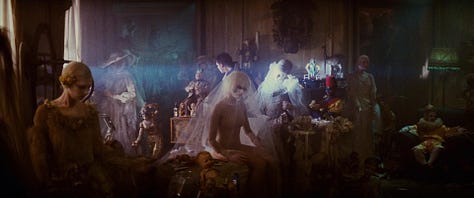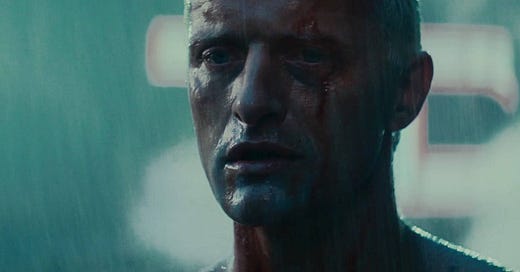BLADE RUNNER
1982 • Ridley ScottCast: Harrison Ford, Rutger Hauer, Sean Young, Edward James Olmos, M. Emmet Walsh, Daryl Hannah, William Sanderson, Brion James, Joe Turkel, Joanna Cassidy
Screenplay: Hampton Fancher, David Peoples; Based on Do Androids Dream of Electric Sheep? by Philip K. Dick
Cinematography: Jordan Cronenweth
Music: Vangelis
Warner Bros.
Quite an experience to live in fear, isn't it? That's what it is to be a slave.
Spoilers Ahead
In 2019, in a futuristic Los Angeles that is decaying from the ground up, Rick Deckard is a "Blade Runner," a person assigned to hunt down and kill renegade "replicants." Replicants are life-like androids created to do the worst jobs that humans will not do on the off-world colonies. When a replicant goes AWOL to try and pass off as a human for the rest of its life, Blade Runners are called in to eliminate the problem. He comes across Rachel, a woman he believes to be a replicant, despite displaying human emotions. But now Deckard has been tasked with eliminating Roy Batty, a dangerous replicant rebel who has been creating all sorts of chaos.
Blade Runner seamlessly operates on multiple levels. At its core, it is a science fiction film that explores complex themes related to artificial intelligence, humanity, and the implications of advanced technology. However, beyond its futuristic setting and technological themes, Blade Runner also unfolds as a compelling noir detective story. The film adeptly captures the essence of film noir through various elements. The urban atmosphere depicted in the dystopian future of Los Angeles is characterized by towering skyscrapers, neon lights, and perpetual rain, creating a dark and foreboding backdrop reminiscent of classic noir settings. The use of lighting techniques, where strong contrasts between light and shadow are employed, contributes to the film's noir aesthetic.
The protagonist, Rick Deckard, is a classic noir detective, navigating a morally ambiguous world filled with replicants and existential questions about what it means to be human. In a lot of hard-boiled detective noirs, the protagonist is an ex-cop turned private investigator. In this case, Deckard is a former Blade Runner instead of cop, but the formula still applies. The replicants, bioengineered beings with limited lifespans, blur the lines between good and evil, right and wrong.
The narrative structure and pacing of the film align with the conventions of noir storytelling. The film unfolds as a mystery, with Deckard unraveling the layers of a complex case that leads to profound philosophical inquiries. The incorporation of femme fatale elements, embodied by characters like Rachael, adds another layer of intrigue and suspense to the narrative, aligning with traditional noir tropes. Rachael (Sean Young) deviates from the traditional femme fatale archetype. Rachael's initial motives are shrouded in mystery, and her relationship with Deckard becomes a focal point of the film's exploration of identity and humanity. As a replicant with implanted memories, Rachael grapples with questions about her own existence and the nature of her emotions. Her journey is one of self-discovery, love, empathy, and trying to distinguish between artificial and genuine emotions.
Roy Batty (Rutger Hauer) is one of the great tragic movie villains in cinema. Replicants in the world of Blade Runner have a built-in four-year lifespan. This inherent limitation is crucial to the character. Knowing that his time is running out adds a sense of urgency and desperation to his actions. Roy's quest for a longer life is a central driving force. His actions are not solely driven by malevolence. His pursuit of Tyrell, the creator of the replicants, is fueled by a desire for an extension of his own existence. This quest for more time reflects the universal human fear of mortality. His most emotional moment is the now iconic "Tears in Rain" monologue. In his final moments, as he reflects on his experiences, Roy reveals a profound understanding of the fleeting nature of life and the beauty of human experience.
Ridley Scott's visionary direction, coupled with the work of cinematographer Jordan Cronenweth, set a new standard for visual storytelling in science fiction cinema. The film's stunning aesthetics have left an indelible mark, and it continues to be celebrated for its timeless and evocative visuals. Despite being released in 1982, an era that predates the widespread use of CGI and advanced special effects technology, Blade Runner remains a triumph of creativity in visual storytelling. The film's dystopian future Los Angeles is brought to life through meticulous set design, intricate practical effects, and a masterful use of atmospheric lighting. The incorporation of miniatures and practical effects, such as the iconic Tyrell Corporation pyramid building, showcases the ingenuity and craftsmanship of the filmmaking team.
Moreover, the film's visual effects team, led by Douglas Trumbull (2001: A Space Odyssey), crafted groundbreaking effects that have stood the test of time. The incorporation of the flying cars and the seamless integration of visual effects with practical elements create a visually immersive experience. Even in a post-Star Wars era, the film's visuals not only defied the limitations of its era but also set a benchmark for the imaginative possibilities within the science fiction genre.
Blade Runner was bogged down in much studio interference by Warner Bros. who thought the film was uncommercial and would be unprofitable. A heavily edited version was released with a voiceover by Harrison Ford to "explain" the film to viewers. The film was heavily panned and failed at the box office. Years later, a "Director's Cut" was released and this is the film that has become a classic amongst critics and audiences, while raising new questions the original release did not. A sequel, Blade Runner 2049, was released in 2017, to widespread acclaim. Blade Runner's influence can not be understated on modern science fiction, and its visuals will ensure it forever lives on as one of the greatest pieces of cinematic art.
I've seen things you people wouldn't believe. Attack ships on fire off the shoulder of Orion. I watched C-beams glitter in the dark near the Tannhauser gate. All those moments will be lost in time... like tears in rain... Time to die.
Notable Awards & Accomplishments
Academy Award Nominee: Best Art Direction-Set Decoration
Academy Award Nominee: Best Effects, Visual Effects
AFI's 100 Years...100 Movies (10th Anniversary Edition) – No. 97
Streaming: Not currently streaming
Digital Rental/Purchase: Available at major digital retailers
Physical Media: Available on 4K, Blu-Ray and DVD
